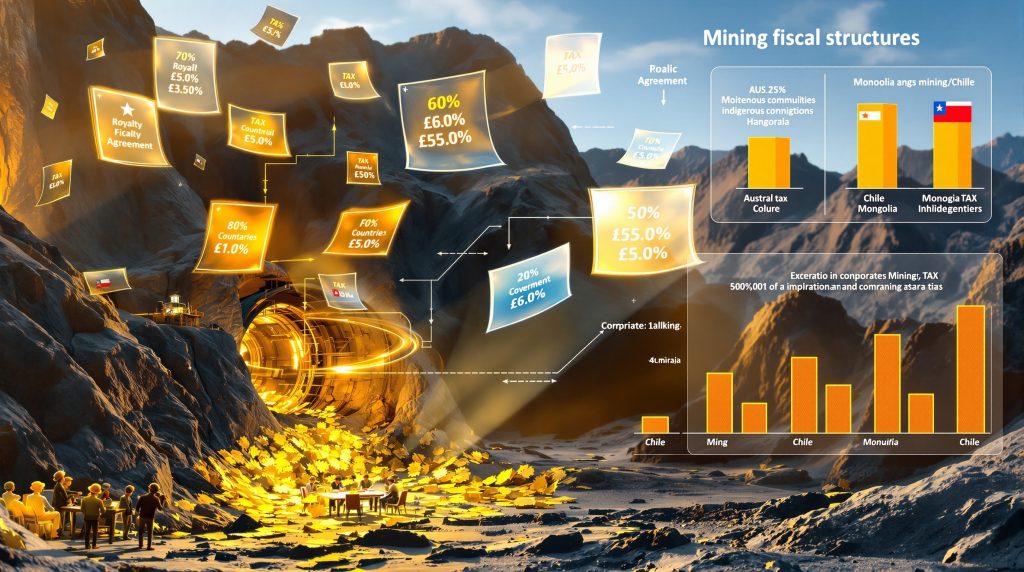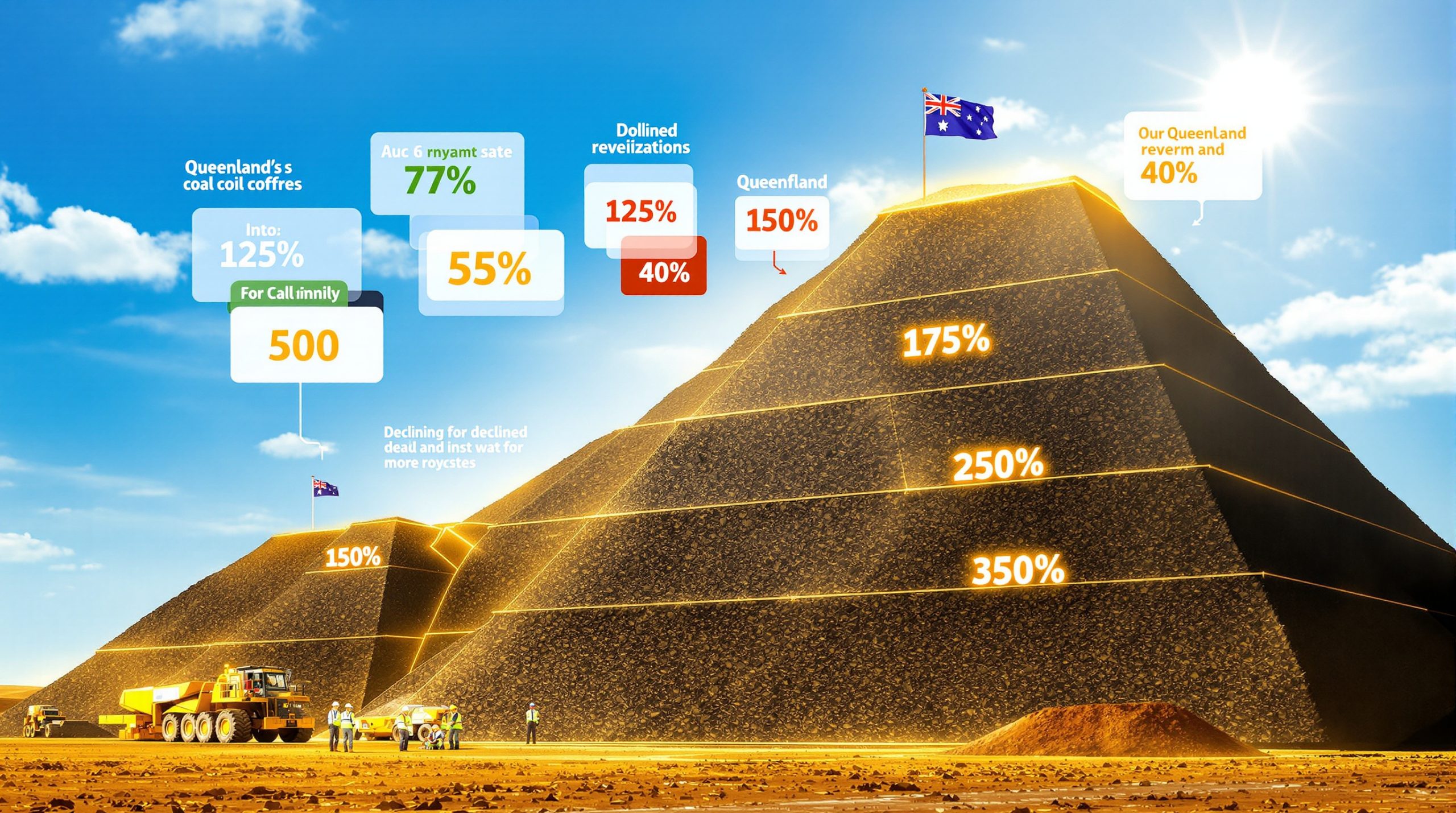Understanding the Complexities of Royalty Agreements in Mining Economics
Royalties represent a cornerstone financial mechanism in mining operations, directly influencing project economics and investment decisions. These payments serve as compensation to resource owners for mineral extraction rights, creating a direct relationship between resource value and financial returns. Understanding how these obligations impact mining economics is essential for both operators and investors navigating this complex landscape.
The Fundamental Nature of Mining Royalties
Mining royalties function as payments to resource owners—typically governments but sometimes private entities—for the right to extract minerals from their land. Unlike profit-based mechanisms, royalties establish a compensation structure that ensures resource owners receive payment regardless of a project's profitability status. This fundamental characteristic makes royalties particularly significant in financial models, as they represent an unavoidable cost that directly impacts cash flow throughout a project's lifecycle.
According to the World Bank's Mining Royalties report, royalty rates globally range from 1-12% of gross revenue or net smelter returns, creating a significant variability in financial impact across jurisdictions and commodities. This variability directly influences investment attractiveness and project economics.
Key Royalty Structures in the Mining Sector
Different royalty structures create varying financial impacts on mining operations, each with distinct calculation methods and implications:
| Royalty Type | Calculation Basis | Financial Impact | Best Suited For |
|---|---|---|---|
| Net Smelter Return (NSR) | Percentage of net revenue after deducting transportation, processing, and refining costs | Moderate impact that acknowledges post-extraction costs | Most mining operations |
| Gross Revenue | Percentage of total mineral sales with minimal deductions | Higher burden that remains constant regardless of operational costs | High-margin operations |
| Net Profit Interest (NPI) | Percentage of operational profits after deducting all costs | Variable impact based on profitability | Mature operations with stable cost structures |
Net Smelter Return royalties dominate the industry, accounting for approximately 60-70% of all mining royalty agreements globally according to Fraser Institute's Annual Survey of Mining Companies. The NSR calculation methodology (Gross Revenue – Transportation Costs – Processing Costs – Refining Costs – Insurance) × Royalty Rate provides a balanced approach that acknowledges the costs incurred after ore extraction.
Mining law experts note that royalty structures significantly influence production decisions, as operators often prioritize higher-grade ore extraction when facing percentage-based royalties to maximize early returns while minimizing royalty payments.
Financial Implications of Royalty Obligations
Royalty payments directly impact project economics through several key mechanisms:
- First-line revenue reduction: Royalties reduce gross revenue before operational costs are considered
- Margin compression: During commodity price downturns, fixed royalty percentages can significantly squeeze profit margins
- Capital recovery impact: Royalty obligations during development phases extend payback periods
- Variable burden: For a typical gold project, a 2.5% NSR royalty can reduce project NPV by 10-15%
- Grade sensitivity: Higher royalty rates increase the cut-off grade required for economic extraction
The cumulative effect of these financial obligations becomes particularly pronounced for marginal deposits or during periods of depressed commodity prices. According to mining investment studies, a 1% increase in royalty rates typically reduces project NPV by 8-12% for marginal deposits, potentially transforming economically viable resources into uneconomic reserves.
What Constitutes Government Take in Mining Operations?
Beyond simple royalties lies a comprehensive fiscal framework that governments implement to ensure public benefit from resource extraction. This multi-layered approach creates a complex financial landscape that mining companies must navigate throughout their operational lifecycle.
Beyond Simple Royalties: The Complete Fiscal Framework
The government take encompasses a comprehensive collection of fiscal instruments designed to ensure public benefit from resource extraction. This multi-layered approach includes:
- Direct taxation mechanisms targeting corporate profits
- Resource-specific levies based on production volumes or values
- Administrative fees and charges throughout the project lifecycle
- Potential equity participation requirements in certain jurisdictions
Government take calculations often create significant administrative complexity. According to international mining taxation studies, the administrative burden of complying with various fiscal requirements can represent 2-5% of project costs, creating an additional indirect financial impact beyond the direct payments.
Primary Components of Government Fiscal Instruments
The government take typically comprises several distinct elements:
- Corporate income taxes: Standard profit-based taxation, often with mining-specific provisions, ranging from 15-35% depending on jurisdiction
- Withholding taxes: Levies on dividends, interest, and service fees paid to foreign entities, typically 5-15%
- Import/export duties: Tariffs on equipment imports and mineral exports, varying widely by country
- Land use fees: Payments for surface rights and access, often calculated per hectare
- Environmental bonds: Financial guarantees for reclamation obligations, sometimes reaching tens of millions of dollars for large operations
- State equity requirements: Mandatory government ownership stakes in certain jurisdictions, ranging from 10-51% for strategic mineral projects
Research indicates the combined effective tax rate for mining projects typically ranges between 40-60% of total project value, creating significant implications for investment decisions. This high overall burden directly influences capital raising insights and allocation decisions across competing jurisdictions.
How Do These Financial Obligations Affect Investment Decisions?
The combined impact of royalties and government take creates a critical decision framework for mining investment. Companies employ sophisticated financial analysis to evaluate how these obligations affect project viability and competitive returns.
The Investment Decision Matrix
Mining companies employ sophisticated financial modeling to evaluate potential investments, incorporating both royalty structures and government take into their analysis:
- Net Present Value (NPV) calculations: Projecting future cash flows discounted to present value
- Internal Rate of Return (IRR) assessments: Determining the percentage return on invested capital
- Payback period analysis: Estimating the timeframe for capital recovery
- Sensitivity testing: Evaluating how changes in royalty rates or tax policies affect outcomes
Investment decision metrics reveal the substantial impact of fiscal regimes on project viability. Mining companies typically require minimum IRR thresholds of 12-15% for base metals and 15-20% for precious metals projects according to PwC's "Mine 2023: Resilience in Uncertainty" report. Higher government take directly extends payback periods, with studies showing that increased fiscal burden can extend capital recovery timelines by 1-3 years depending on project scale.
Investment analysts emphasize that fiscal regime uncertainty creates risk premiums that can increase required returns by 3-5 percentage points. This uncertainty effect means jurisdictions with unpredictable tax authorities update policies must offer significantly higher geological potential to attract equivalent investment.
Balancing Stakeholder Interests
The optimal fiscal regime balances multiple competing interests:
- Government revenue objectives: Maximizing public benefit from resource extraction
- Investment attractiveness: Creating conditions that attract capital
- Community development needs: Ensuring local populations benefit from resource development
- Environmental stewardship: Funding proper environmental management and reclamation
Finding this balance requires thoughtful policy development that acknowledges both short-term revenue needs and long-term investment sustainability. Studies have demonstrated that increases in government take above 50% can reduce mining investment by 20-40% over a 5-year period, creating a direct trade-off between immediate revenue and sustainable development.
What Makes an Effective Mining Fiscal Regime?
Effective mining taxation frameworks balance multiple objectives while creating predictable conditions for investment. These regimes recognize the unique characteristics of mining projects, including long development periods, high capital intensity, and commodity price volatility.
Principles of Sustainable Mining Taxation
Effective fiscal regimes for mining typically embody several key principles:
- Stability: Providing predictable financial obligations throughout project lifecycles
- Progressivity: Allowing government take to increase as profitability rises
- Transparency: Creating clear, understandable fiscal terms
- Competitiveness: Maintaining reasonable burdens relative to competing jurisdictions
- Administrative simplicity: Minimizing compliance costs and bureaucratic complexity
Tax policy experts emphasize that progressive tax systems allowing government take to increase with profitability create better alignment between public and private interests. This approach ensures that governments capture a higher share during commodity booms while providing relief during downturns, creating a more sustainable investment environment.
Stability agreement prevalence underscores their importance in investment decision-making. Approximately 40% of major mining projects globally operate under some form of fiscal stability agreement, with these agreements typically ranging from 10-25 years for major mining projects. This prevalence reflects the industry's need for long-term fiscal certainty given the extended timeframes of mining investments.
Case Studies: Contrasting Fiscal Approaches
Different jurisdictions demonstrate varying approaches to mining taxation:
Chile's Sliding-Scale Royalty System
Chile employs a progressive royalty structure that adjusts based on operational scale and profitability:
- Lower rates for smaller operations to encourage development
- Increasing rates as production volumes and profits grow
- Stability agreements for large-scale investments
This approach has helped Chile maintain its position as a leading copper producer while ensuring the government captures appropriate value from its mineral resources. The progressive nature of the system provides relief during market downturns while capturing higher value during boom periods.
Mongolia's Strategic Deposit Framework
Mongolia demonstrates the challenges of balancing investment attraction with resource nationalism:
- Mandatory state participation in strategic deposits
- Negotiated stability agreements for major projects
- Evolving fiscal terms reflecting political changes
Mongolia's experience with the Oyu Tolgoi project highlights the challenges of changing fiscal terms during project development, which created significant investor uncertainty and delayed development of this world-class copper deposit.
Canada's Mining Tax Approach
Canada has implemented a mixed system that varies by province:
- Provincial mining taxes based on profits rather than revenues
- Processing allowances to encourage domestic mineral beneficiation opportunities
- Exploration incentives through flow-through share mechanisms
This approach has helped Canada maintain a competitive position for mining investment while ensuring provinces benefit from resource development within their borders.
These contrasting approaches highlight the diversity of fiscal frameworks globally and their impact on investment flows. Each model represents different trade-offs between government revenue maximization and investment attraction.
How Can Mining Companies Navigate These Financial Complexities?
Mining companies employ various strategies to manage fiscal obligations while maintaining project viability. These approaches range from early engagement with authorities to sophisticated financial structuring.
Strategic Approaches to Fiscal Management
Mining companies employ several strategies to effectively manage royalty and tax obligations:
- Early engagement with governments: Proactively discussing fiscal terms during project development
- Fiscal stability agreements: Negotiating contractual protections against policy changes
- Financial modeling sophistication: Employing advanced analytics to project fiscal impacts
- Operational optimization: Adjusting mine plans to maximize returns under fiscal constraints
- Corporate structuring: Establishing appropriate legal entities to manage fiscal obligations efficiently
Large mining companies report using fiscal stability agreements in 60-70% of their international projects according to Deloitte's "Global Mining Tax Survey". These agreements provide contractual protection against future tax increases, creating greater certainty for long-term investment planning.
Corporate strategy advisors recommend early government engagement, with studies showing that companies engaging fiscal authorities during pre-feasibility stages achieve 15-25% better fiscal terms. This early dialogue helps align expectations and creates a foundation for sustainable fiscal relationships.
Risk Mitigation Strategies
Effective risk management for fiscal obligations includes:
- Scenario planning: Preparing for potential policy changes through robust modeling
- Diversification: Balancing portfolio exposure across multiple jurisdictions to reduce concentration risk
- Community investment: Building social license to strengthen negotiating positions with authorities
- Transparency initiatives: Participating in disclosure programs like EITI (Extractive Industries Transparency Initiative)
- Industry collaboration: Working through associations to advocate for reasonable fiscal policies
These strategies help mining companies maintain operational flexibility while managing fiscal uncertainties. Risk mitigation approaches have evolved significantly in recent years, with companies increasingly incorporating political risk insurance and fiscal hedging instruments into their strategic planning.
What Does the Future Hold for Mining Fiscal Regimes?
The mining fiscal landscape continues to evolve in response to changing economic conditions, social expectations, and environmental considerations. Several key trends are reshaping how governments approach resource taxation.
Emerging Trends in Resource Taxation
Several key trends are reshaping mining fiscal frameworks globally:
- Resource nationalism resurgence: Increasing government demands for greater economic participation
- ESG integration: Incorporating environmental and social performance into fiscal incentives
- Carbon pricing mechanisms: Implementing climate-related taxation affecting operational costs
- Beneficiation incentives: Offering tax advantages for local processing and value addition
- Digital taxation: Addressing technology-driven changes in mining business models
Fraser Institute surveys show increasing government intervention in mining sectors, with 35% of jurisdictions implementing new fiscal measures in 2022-2023. This trend reflects growing public expectations for greater local benefits from resource development.
Industry analysts predict continued evolution toward ESG-linked fiscal incentives, with carbon pricing mechanisms expected to affect 50% of mining operations by 2030. These mechanisms include carbon border adjustments and emissions-linked tax credits, creating new financial considerations for mining operations.
Recent developments in critical minerals policy have further influenced how governments approach fiscal regimes for strategically important resources. Beneficiation incentives represent an increasingly common approach to promoting in-country value addition. These incentives typically offer 20-40% reductions in standard rates for companies that process minerals domestically rather than exporting raw materials.
Balancing Competing Priorities
The future effectiveness of mining fiscal regimes will depend on balancing several competing priorities:
- Revenue maximization vs. investment attraction
- Short-term fiscal needs vs. long-term industry sustainability
- Standardization vs. project-specific flexibility
- Administrative simplicity vs. comprehensive revenue capture
- National interests vs. global competitiveness
Finding this balance will require ongoing dialogue between industry, governments, and communities. Jurisdictions that successfully navigate these competing priorities will likely emerge as preferred investment destinations, while those that fail to find an appropriate balance may see declining investment despite significant resource potential.
FAQ: Understanding Mining Royalties and Government Take
What is the difference between royalties and taxes in mining?
Royalties represent payment for the right to extract minerals, functioning as compensation to the resource owner (often the state), while taxes are broader government levies on business activities, profits, or transactions. Royalties typically apply regardless of profitability, while many taxes only become payable when operations generate profits. This fundamental difference creates distinct cash flow impacts, with royalties affecting operations even during unprofitable periods.
How do royalty rates typically vary by commodity?
Royalty rates often reflect both commodity value and extraction economics:
- Precious metals (gold, silver): Typically 2-5% of value
- Base metals (copper, zinc): Often 2-4% of value
- Bulk commodities (iron ore, coal): Generally 1-3% of value
- Critical minerals (lithium, cobalt): Increasingly 3-6% of value
These variations acknowledge differences in profit margins and strategic importance across commodity types. Critical minerals have seen increasing royalty rates in recent years as governments recognize their strategic importance in energy transition technologies.
Can mining companies negotiate better royalty terms?
Negotiation possibilities vary significantly by jurisdiction:
- Some countries maintain fixed, non-negotiable statutory rates
- Others offer flexibility for major projects or strategic investments
- Developing nations may provide more negotiation room to attract investment
- Stability agreements can lock in terms for extended periods
Successful negotiations typically involve demonstrating significant economic benefits beyond direct revenue. Companies that can effectively communicate broader economic development impacts, including local employment, infrastructure development, and skills transfer, often achieve more favorable fiscal terms.
How do indigenous land rights affect royalty structures?
Indigenous rights create additional complexity in royalty frameworks:
- Many jurisdictions require separate agreements with indigenous communities
- These may include impact-benefit agreements with royalty-like payments
- Some legal frameworks mandate revenue sharing between governments and indigenous groups
- Modern agreements often include training, employment, and business development provisions
These arrangements reflect evolving recognition of indigenous resource rights globally. In countries like Canada and Australia, these agreements have become standard practice and often include royalty-like payments directly to indigenous communities in addition to government royalties.
Conclusion: Finding the Optimal Balance
The interplay between royalty agreements and government take creates a complex financial landscape that fundamentally shapes mining investment decisions. Effective fiscal regimes must balance legitimate government revenue needs with creating conditions that attract investment capital. For mining companies, navigating these fiscal complexities requires sophisticated financial analysis, proactive government engagement, and strategic planning.
As resource nationalism trends continue alongside growing ESG expectations, finding this balance becomes increasingly challenging. However, transparent, stable, and progressive fiscal frameworks that adapt to changing economic conditions while providing reasonable returns to all stakeholders represent the most sustainable approach to resource development.
The most successful mining jurisdictions will be those that recognize the need for fiscal frameworks that evolve with changing economic conditions while providing sufficient stability for long-term investment planning. Similarly, mining companies that proactively engage with fiscal policy development while maintaining operational flexibility will be best positioned to thrive in this complex environment.
Mining fiscal regimes that incorporate flexibility during commodity price downturns while capturing higher value during price booms create more sustainable investment environments. These progressive approaches align government and industry evolution trends by sharing both risk and reward throughout the commodity cycle.
The complexities of royalty agreements and government take remain central considerations in mining investment decisions, requiring careful analysis, strategic planning, and ongoing stakeholder engagement to navigate successfully.
Ready to Capitalise on the Next Major Mineral Discovery?
Discovery Alert instantly notifies investors about significant ASX mineral discoveries using its proprietary Discovery IQ model, transforming complex data into actionable investment insights. Understand why historic discoveries can generate substantial returns by visiting Discovery Alert's dedicated discoveries page and begin your 30-day free trial today to position yourself ahead of the market.




